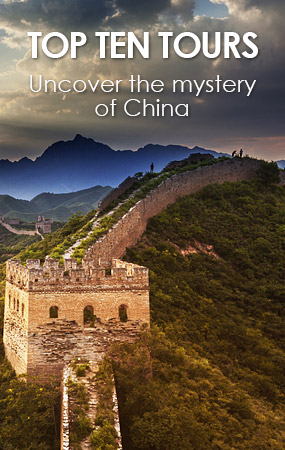Dingling Tomb and Changling Tomb
The Gate of Ling En means the Gate to Paradise. In the second courtyard of Emperor Yongle's Tomb, you'll find the Ling En Palace which is the most imposing building in the mausoleum area. The palace stands on a 3.2 metres high, three storeyed marble foundation, with white marble steps leading to the palace hall and surrounded by white marble balustrades.
The palace is 61 metres in width and 29 metres in depth, total area is 1956 square meters, 60 gold filigree Nanmu Column support the whole palace, which matches the Hall of Supreme Harmony in the Forbidden City for its grandeur. This Nanmu Palace is the largest among buildings of wooden structure has stood over 500 years of wind and rain without slightest tilt or deformation.
In the 3rd courtyard is inner red gate and Soul Tower (Ming Lou), the Soul Tower is situated on the 10 metre high Baochen which is a walled city. Behind Ming Lou is Baoding which is a long shaped structure over 1 Km in circumference, under the center of Baoding is the Underground Palace where Zhu Di, the Emperor Yongle was buried.
Zhu Di was the 3rd emperor of the Ming Dynasty and he built this this tomb when the capital was moved to Beijing. Emperor Yongle's Tomb is the largest, earliest and best preserved among the 13 mausoleums.
Emperor Yongle's Tomb is now one of the three Ming tombs which are open to visitors.
Zhu Yijun, the emperor Ming Shenzong built Dingling for himself. He ascended the throne at nine with the title Wanli and reigned for 48 years, he is the 13th emperor who reigned the longest in the Ming Dynasty, Zhu Yijun personally choose the site and was involved in the planning and construction of his mausoleum.
In 1584, the 21 year old emperor Wanli decided on the site of Dingling and assembled thousands of workers, civilians, troops to take part in its construction. The workforce on the construction site was more than 30,000 each day.
Normally, no emperor would build a tomb bigger than his ancestors'. However, the scale, materials used and workmanship exceeded Yongling in many aspects. The construction of Emperor Wanli's Tomb took 56 years to complete. About 250 tons of silver was used in construction. This corresponded to two years of state revenue.
Emperor Wanli's Tomb is the only one of the 13 Ming Tombs excavated so far. Excavation work started in 1956, and finished in 1958. The excavation work unearthed many historical relics which are now on display in the Dingling Musuem. Dingling Museum was opened to public in 1959. It has an underground Palace and two exhibition rooms. One presents the process of the excavation and the other displays the treasure unearthed in the underground palace.
Emperor Wanli had two wives. The first wife Empress Xiaoduan had no son, she died only several months before his death and she was entitled to share the mausoleum with the emperor. The second wife Empress Xiaojing, who gave birth to the only son of the emperor died in 1612, eight years before the emperor's death and was buried only as an imperial concubine in a nearby tomb.
The only son of the second wife succeeded the throne but died within a month after his succession. He left the throne to his son. After the grandson became the emperor, he decided to promote his grandmother to the rank of Empress Dowager so that she could share the Tomb with Emperor Wanli. This is the reason that Emperor Wanli shares his tomb with two wives.
Please follow me to the two sketch maps of the Ming Tombs. This map gives us a panoramic view of the whole 13 Ming Tombs, while the other shows the Underground Palace of Emperor Wanli's Tomb.
Dingling means the Tomb of Certainty, it is Emperor Wanli's Tomb. The other Soul Towers reveal the location of the other tombs. The Gate of Dingling and the Soul Tower are shown on the sketch map. In front of the Soul Tower are two exhibition halls, one on each side. Underneath the Soul Tower is the 27 metre deep Underground Palace.
The Underground Palace is composed of five joint halls in the front, middle, back, left and right respectively. All are built from marble. After completion of the Underground Palace, the emperor Wanli held a grand feast in it to celebrate its completion. Thirty-eight years later, Emperor Wanli died, he and two queens were buried together.

